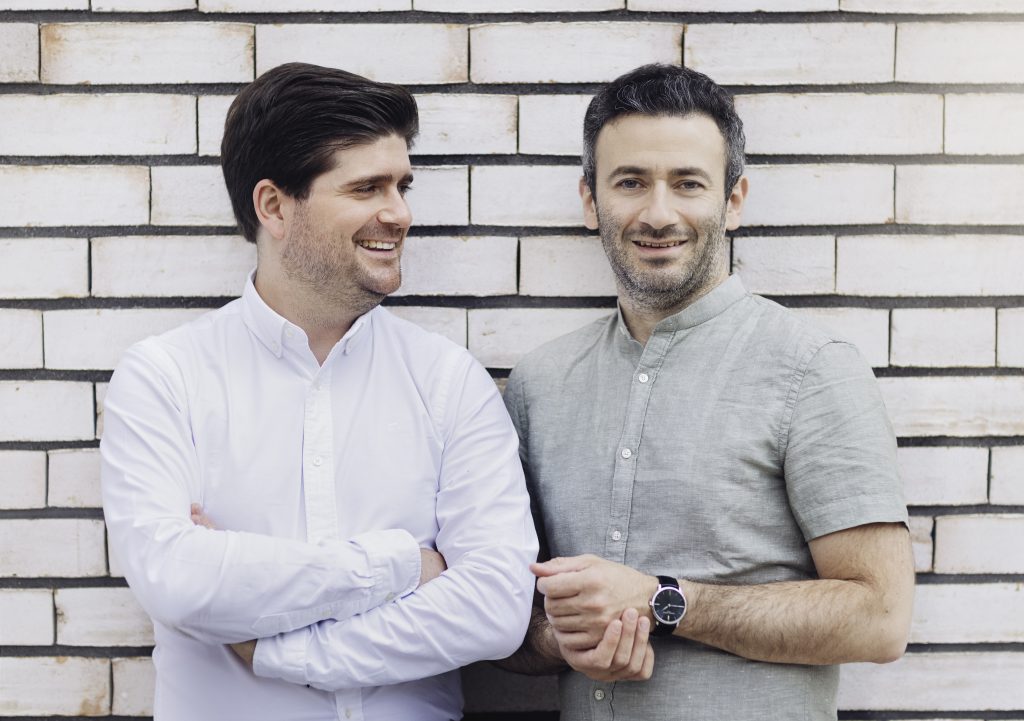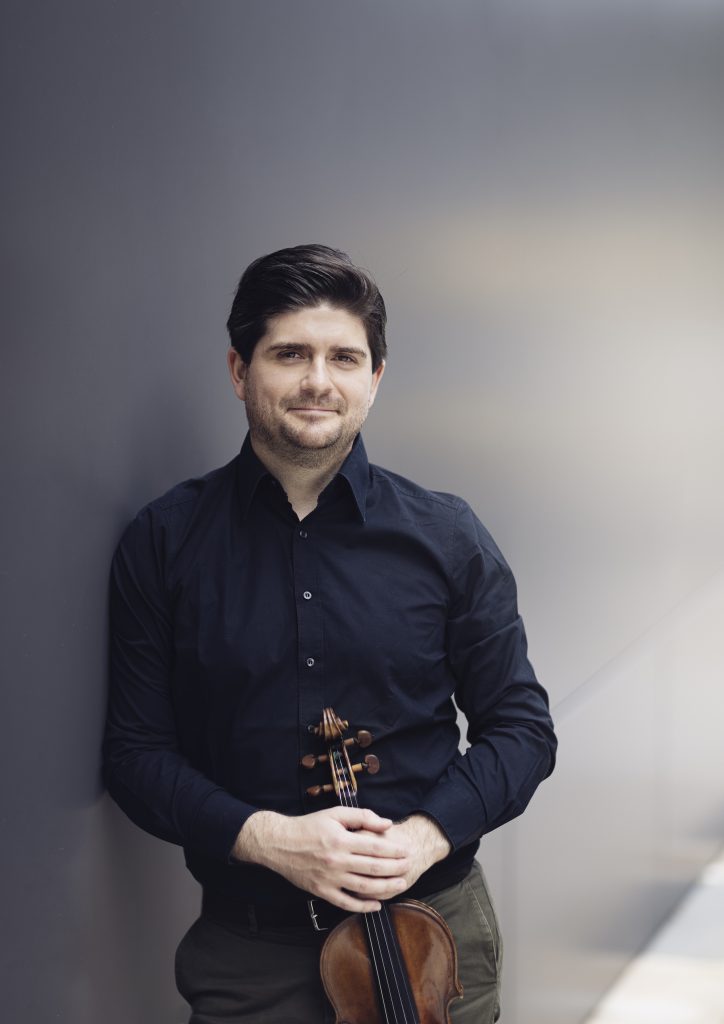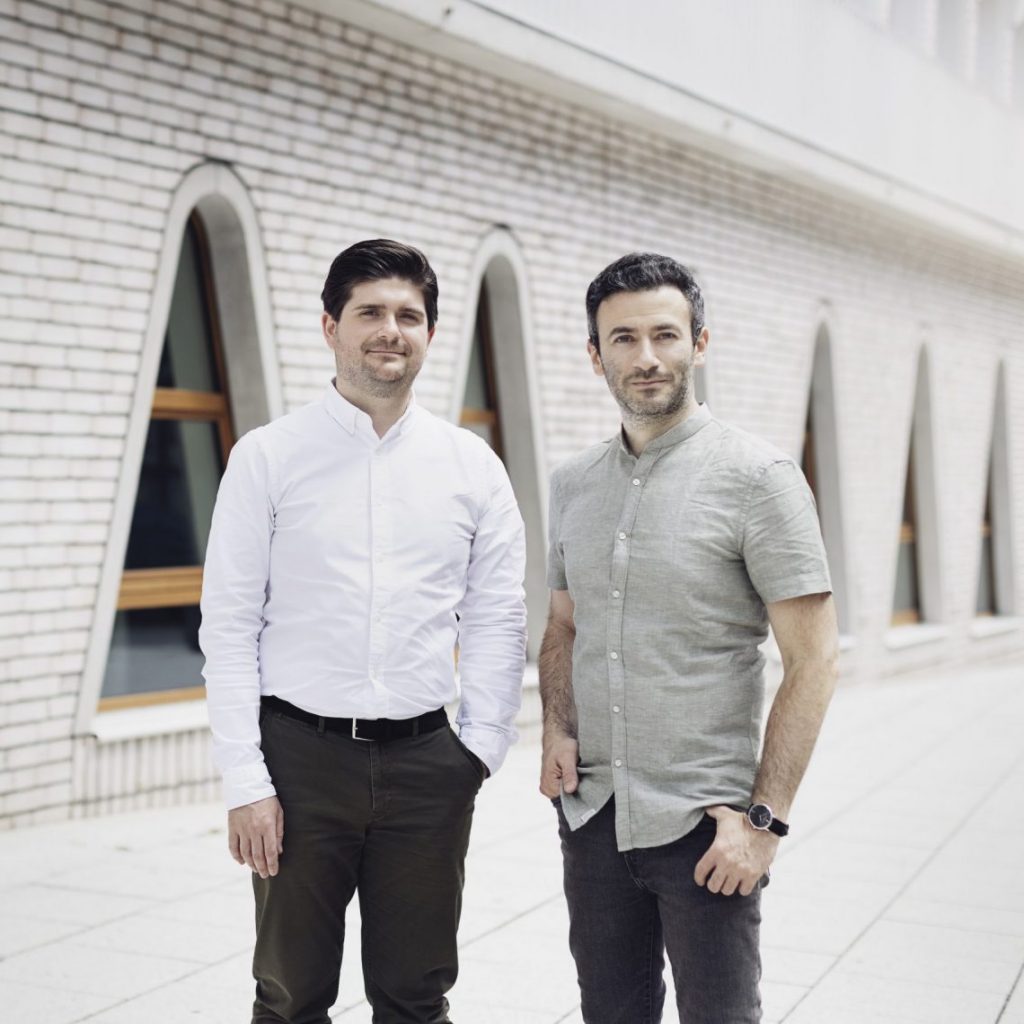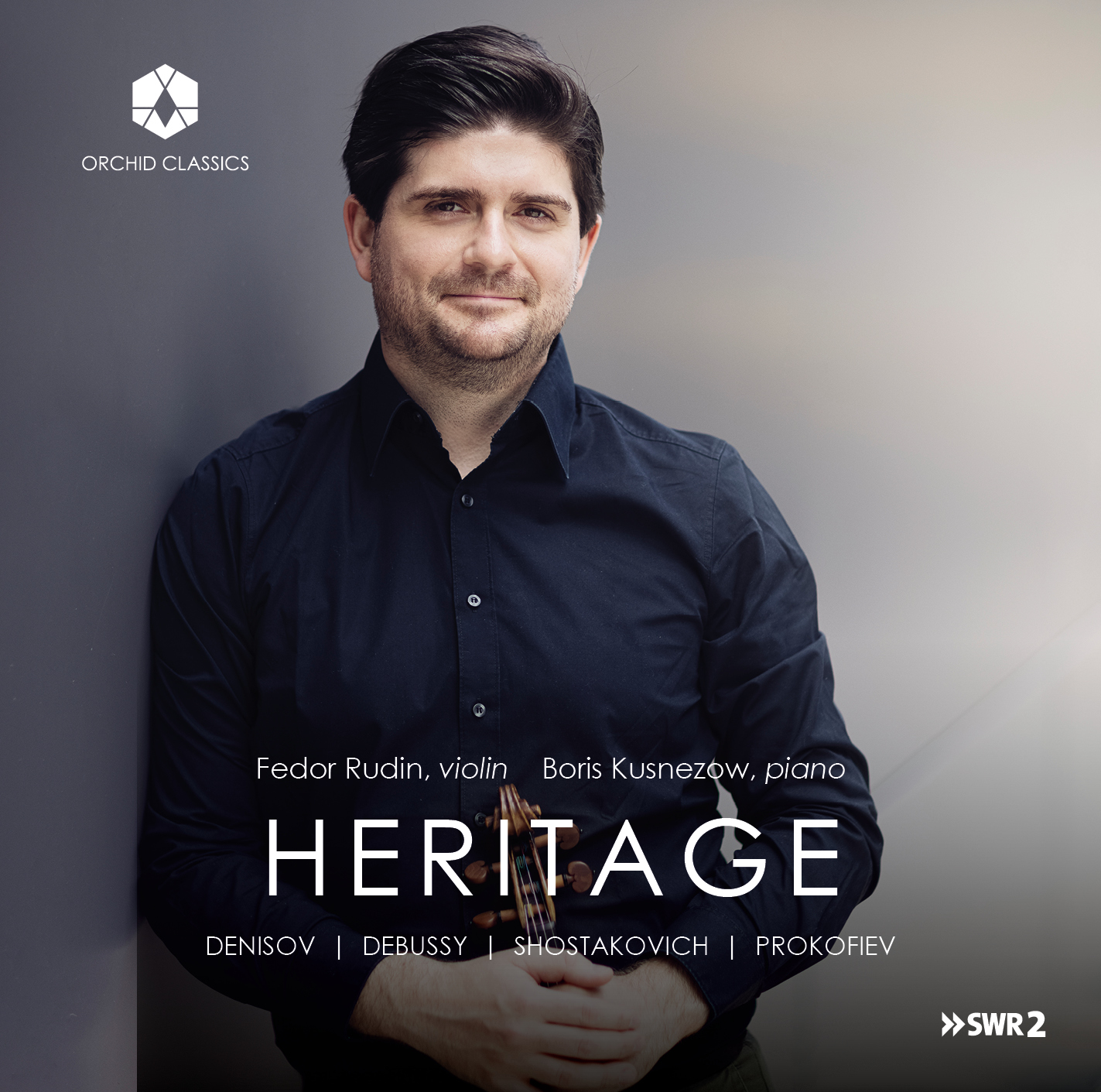Press Release
For press enquiries please contact alex.patel@orchidclassics.com. Tel: +44 7717 663481
On this fascinating new release, violinist Fedor Rudin and pianist Boris Kusnezow perform works by mid-20th-century Russian composers including Rudin’s own grandfather Edison Denisov, Dmitri Shostakovich and Sergei Prokofiev.



Heritage
Edison Denisov (1929-1996)
Three Concert Pieces for violin and piano, Op.15
1. I Improvisation
2. II Adagio
3. III Dance (“Plyaska”)
Claude Debussy (1862-1918)
4. Prelude and Duo scene from the opera
Rodrigue et Chimène orchestrated by Edison Denisov,
arranged for violin and piano by Fedor Rudin
Edison Denisov
Sonata for violin and piano
5. I Allegro moderato
6. II Largo
7. III Vivace
Dmitri Shostakovich (1906-1975)
Sonata for violin and piano in G minor
8. I Moderato con moto (unfinished)
Sergei Prokofiev (1891-1953)
Sonata No.1 for violin and piano in F minor, Op.80
9. I Andante assai
10. II Allegro brusco
11. III Andante
12. IV Allegrissimo
Edison Denisov
Sonatina for violin and piano
13. I Andante
14. II Allegretto
Modest Mussorgsky (1839-1881)
15. “Hopak” from the opera Sorochinsky Fair
arranged for violin and piano by
Sergei Rachmaninoff
Fedor Rudin, violin
Boris Kusnezow, piano
The program of this CD includes works written by composers of different generations in the middle of the last century – Sergei Prokofiev, Dmitri Shostakovich, and Edison Denisov. The listener will find well-known, regularly performed works, as well as previously unperformed and even unpublished works.
Among such rarities is a fragment of a movement from Dmitri Shostakovich’s unfinished Sonata for violin and piano (1945). One can hear in it the “forerunners” of the motifs from his Second Piano Trio in memory of I. Sollertinsky, written soon afterwards, especially in the second subject with its grotesque character and strongly “Jewish” tonal language. The first theme is coloured with a deeply intimate lyricism that is rare for Shostakovich’s style. The fragment ends in the recapitulation before an unfinished presentation of the second theme, but this does not affect the holistic perception of this brilliant, completely independent piece.
Edison Denisov’s Sonata for violin and piano (1963) belongs to a completely different musical era. Edison Denisov was a representative of the Russian post-avant-garde of the 1960s. In the second half of the 20th century, new composition techniques were developing while continuously displacing the traditional tonal thinking. Denisov’s work reflects typical signs of that period – the development of dodecaphony and serialism in the early days, then the emergence of a synthetic form of those techniques, which combined free chromaticism together with elements of tonality. His cantata The Sun of the Incas from 1964 on verses by Gabriela Mistral opened him the way to European audience, it was performed by Pierre Boulez in Paris that same year. In this work, the young Denisov masterfully operates with the technique of dodecaphony. His Sonata for violin and piano (1963) also belongs to the same early days of his art. It marks the start of a series of sonatas for various instruments and piano – sonatas for saxophone, flute, cello. Those works were all written in the 1970s and its first performers were Jean-Marie Londeix, Aurèle Nicolet and Natalia Gutman. The first interpreter of the violin sonata was Gidon Kremer and the piano part was performed by Oleg Maisenberg (Moscow, 1972).
The first movement Allegro moderato presents right in the first theme the series on which the whole cycle is built: C sharp, F sharp, A, C, D, E flat, G, B flat, F, A flat, B, E. The music is characterised by its energetic character, the “dialogue” between violin and piano is rhythmically complex (with constant metric changes). The interval chord structures of the series and their melodic variations create an intense flow of sound. The second movement, Largo, is a mournful recitative for violin in duet with the piano; a lyrical confession that is only rarely to be heard with the technique of dodecaphony in music history. The ornamental figures go back to the music of the Baroque and are reminiscent of Bach’s instrumental recitatives, they are used in canon technique, both instruments having expressive roles. The Finale, Vivace, is a dynamic rondo that is permeated with nervous rhythm, incessant movement and dynamics; melodic outlines may be guessed only in the second theme. At the end of the Finale, one can hear a fragment from the Largo recitative again; the sonata then ends with the opening theme of the first movement in a slow, dying motion and calm dynamic.
The never performed Three Concert Pieces for violin and piano (1958) by Edison Denisov were written during his student days. They are marked with Op.15, which indicates that there is a significant number of works that the composer left behind handwritten and unpublished (1). These early works are skilfully polished miniatures with brilliant themes, interesting textures, and various modal colours. One can feel in them the influence of Shostakovich, which was particularly relevant for the composer during these years; another source of stylistics is the Russian classic, echoes of folkloric motifs that are clearly manifested in melodic and metric/rhythmical structures. Those pieces are forerunners to the “dodecaphonic” period of Denisov’s work. Much in them is anticipating his subsequent compositions, as the first movement of the Sonata for violin and piano from 1963, the Bagatelles soon to be written for piano (1960). The composer’s interest in the violin was aroused by his friendship with violinists – among whom Mark Lubotsky (to whom the piece Dance is dedicated), Irina Bochkova, Valentin Zhuk (dedicatee of the Adagio) – they all were among the first interpreters of his early works.
The unpublished and never performed Sonatina for violin and piano, written much later (1972)1, is a kind of return to Denisov’s earlier works. The two movements (Andante, Allegretto) are written in tonal technique, the melodic opening contrasting with a scherzo-like second movement. A lot of polyphonic textures and the technique of metric/rhythmical interruptions is used in both of them, reminding a lot of the Bagatelles for piano.
Sergei Prokofiev’s Sonata No.1 in F minor, Op.80 was completed in 1946. The drafts were made around 1938, before the war, therefore it is called “first”, although the composer wrote his second sonata in the meantime, which was originally intended for flute and piano. The first interpreter of the Sonata in F minor was David Oistrakh (on October 23, 1946 in the Small Hall of the Moscow Conservatory, together with Lev Oborin at the piano).
Prokofiev’s violin sonatas are very different. While the second is stylistically closer to his Classical Symphony Op.25, transparent in texture, full of light lyricism and humour, the first is reminiscent of the composer’s work in connection with pictures from the Russian epos and heroism, reflecting his music for the film Ivan the Terrible or his cantata Alexander Nevsky. The sonata consists of four movements that contrast as images of either an epic or a theatrical-heroic character; one may see a hidden program in it.
The first movement Andante assai is like a prelude to the cycle; it introduces the world of Russian legends, restrained, harsh and narrative. The second movement, Allegro brusco, is in strong contrast to the previous one; a tremendous force is set into the music, as well as warlike-sounding, hard unison motifs, whose “offensive” character is associated with many pages of Prokofiev’s music. The third movement Andante is a new contrast in the cycle. The music here is of a truly magical beauty, enchanted, with particularly intimate lyricism. A beautiful cantilena comes with fine harmonic transitions, in distant registers. The character of the Finale, marked Allegrissimo, is once more warlike and offensive. The kinetic energy reminds the final movements of Prokofiev’s piano sonatas (especially the seventh); its melodic expressions and variable metrics are associated with Russian stylistics. The second subject is in the style of a Russian lyric song.
© Galina Grigoreva
First wife of Edison Denisov, grandmother of Fedor Rudin
(1) The manuscripts of those pieces were provided by the composer’s widow Ekaterina Kouprovskaia-Bruggeman from Edison Denisov’s archive.
_________________________
Rodrigue et Chimène, an unfinished opera from the 1890s by the young Claude Debussy, then almost 30-year-old, is based on a libretto by Catulle Mendès. It was only first performed at the Opéra de Lyon in 1993. Edison Denisov, Claude Debussy’s lifelong admirer, was commissioned to complete and orchestrate the opera.
With this arrangement for violin and piano, the aim was less to create a Fantasia or a virtuoso bravura piece for violin, but to try to reproduce the orchestral atmosphere of the Denisov version with the means of violin and piano, and thus to awake an interest in Debussy’s forgotten opera. The violin is therefore not only in the foreground as a performer of the two main characters in this duet, but also partly takes on important colours and functions of other orchestral instruments. Debussy’s Preludes for piano and his late Sonata for violin and piano served as a model in this arrangement, for the composers’ treatment of the two instruments.
The performed piece combines the Prélude of the opera with a duet scene from the first act, close to the beginning of the play, in which Rodrigue and Chimène meet before dawn in front of Don Gomez’s house. The scene depicts both love and worry between the two protagonists, before they are interrupted by Gomez’s men.
© Fedor Rudin
_________________________
Interview on Edison Denisov with Vladimir Jurowski, 15.08.2021
Fedor Rudin: You come from a Russian family of musicians with a long tradition, your grandfather was also a composer. Can you remember your first contact with Edison Denisov’s music?
Vladimir Jurowski: The first conscious contact took place sometime in the 80s, I must have been around 16. Back then, my father was conducting Denisov’s one-act opera “The Four Girls” based on Picasso. Denisov was also at our home from time to time, and we met several times in Rusa (in a composers’ village near Moscow). He was also in the music school of the Moscow Conservatory, where I studied music theory, in order to give a lecture about contemporary music on the invitation of some students. Back then, there was a lot of contact between my father and Denisov, and it turned out that I got to know his two children and his first wife very well. Later I also noticed that I already knew Denisov’s music from film and radio productions, such as “Karlsson on the Roof” by Astrid Lindgren, or “Aladdin’s Magic Lamp”. I already knew these recordings as a small child. This music has always somehow magically attracted me, although it sounded a bit different from his “serious” music, but there, too, you can recognize very specific traits, his compositional handwriting. Denisov was totally consistent in this regard, whether he composed for children, adults, for film, for radio or for concert halls and opera houses, he always remained true to himself. In contrast to some other composers, who changed their style depending on what they were writing for, depending on the context of the commission, until almost completely unrecognizable. That was never the case with Denisov, he can always be recognized after two bars.
F. R. : It is often said of composers that they are “revolutionaries of their time”. What role did Edison Denisov play in the development of contemporary music in what was then the Soviet Union?
V. J. : He was a pioneer of post-war modernism, contemporary music in Russia, together with Andrei Volkonsky. He acted both as an artist and as a kind of teacher, a kind of “avatar” of this movement. He was also a bit older than the others (if you think of Alfred Schnittke or Sofia Gubaidulina, for example, she was born in 1931, Schnittke in 1934. Denisov was born in 1929, and went this way before them). He also kept in close contact with his colleagues in the West, especially in France. He was close friends with Pierre Boulez. At that time, visitors from western countries were still something relatively unusual for us. They did come from time to time, for example Luigi Nono was a relatively frequent guest because he was also a member of the Communist Party in Italy. As far as I know, Boulez came once or twice in the 1960s. Then again when I was already studying, that was in the mid-80s. Denisov’s friendship with Boulez was a very important sign, a symbol of the connection from East to West.
In contrast to other composers, Denisov was also a very active and extremely talented teacher. One can say that with his school of composition he embodies a second direction of the Moscow school. The first direction of this school arose around Nikolai Myaskovsky in the first half of the 20th century, and there were of course other very important teachers at the Conservatory, such as Vissarion Shebalin or Dmitri Shostakovich, but I would say that Denisov’s school, from its importance, comes immediately after that of Myaskovsky. Denisov is also one of the co-founders and initiators of the ACM (Association of Contemporary Music), which still existed in the Soviet Union in the 20s and early 30s, but was stunted due to the Stalinist policy for culture and was replaced by the Composers’ Association. Denisov brought it back to life together with Faradj Karayev, Alexander Vustin, Vladimir Tarnopolski, Yuri Kasparov and Viktor Yekimovski in the 80s and 90s. That was a very important step away from the Soviet ideological dictatorship.
F. R. : Edison Denisov has been studying a lot of earlier and contemporary Russian, but also French music. This includes Sergei Prokofiev and Dmitri Shostakovich, who was like a mentor to him at the beginning of his studies. Nevertheless, Denisov distanced himself from the art of both composers. Which characteristics of Shostakovich and Prokofiev, whose works can be heard on this CD, have shaped Denisov?
V. J. : Denisov’s relationship with Shostakovich was very complicated, and he took different positions on Shostakovich’s music at different times in his life. When he gave this lecture on contemporary music at the Conservatory around 1988/89, his main argument against Prokofiev and Shostakovich was not only that they followed the Soviet ideology and, so to speak, helped to shape the Soviet music dogma. He also tried to argue musically. These musical objections were directed primarily against Shostakovich, less against Prokofiev. He had gone the wrong “Hindemithian” way of two-voice polyphony.
Denisov was a great admirer of French Impressionism, especially the music of Claude Debussy, and he was also a great admirer of the music of Modest Mussorgsky, who is in some ways a forerunner of Debussy. His opinion about Prokofiev did not change in the course of his life. I have also realised that there is a lot of Shostakovich in his very late works, for example in the 2nd Symphony, which I conducted several times. Overall, in his opinion, Russian music had gone the wrong way after Scriabin, namely either the “superficial” way of Prokofiev or precisely this “wrong” way of Hindemith. When Barenboim programmed Denisov’s 1st Symphony in Paris and later in Chicago and he was planning Prokofiev’s 3rd Piano Concerto in the first part of the concert, Denisov was very upset and asked him, why he was programming this bad work.
F. R. : You are one of the most active interpreters of Edison Denisov’s works nowadays. How would you describe the access to his music and programme it today?
V. J. : This is an interesting question. When Denisov was still alive, he had his very specific, very clearly separated taste. There was music he loved and music he couldn’t stand. Mozart, Schubert, Debussy – he couldn’t get enough of them. Hindemith, Prokofiev and Shostakovich, on the other hand, upset him, and he could get very angry if his works were played together with this music. I dared such experiments, I programmed his music with Debussy, Mozart and Schubert as well as in the same program with Alban Berg and Dmitri Shostakovich. For example, I conducted a program in London with the last three works by three composers: there was Denisov’s 2nd Symphony, Berg’s Violin Concerto and Shostakovich’s Symphony No.15, and it perfectly fitted together. I think now that Denisov’s music is already part of our history, you can definitely allow yourself to program him with composers he didn’t like. Just as we often experience music by Brahms and Wagner or Tchaikovsky and Brahms in the same concert today, although the composers didn’t like each other at all, as we know.
For example, I would definitely program the Violin concerto, which I have not conducted yet, with a work by Schubert and perhaps Mozart, because I am of the opinion that, strangely, it is precisely through these composers that one understands the purity of Denisov’s music best. He was an avowed classic and classic lover. Mozart and Schubert were his two guiding stars. We had the idea together to perform the Violin concerto, which unfortunately fell through the pandemic. I very much hope that we will catch it up.
French-Russian violinist Fedor Rudin explores and pays tribute to his heritage via this rich collection of works, including his own arrangement of Denisov’s orchestration of Debussy’s ‘Prelude and Duo’, which comes from Debussy’s unfinished opera, Rodrigue et Chimène. Other gems include Denisov’s rarely-heard Three concert pieces for violin and piano (1958), and his previously unpublished Sonatina (1972), which marks a return to his melodic youth after the musically experimental interim years. Those years are represented here by Denisov’s dodecaphonic Sonata (1963).
We also hear an unfinished Sonata by Shostakovich, Rachmaninoff’s arrangement of Mussorgsky’s ‘Hopak’ from his opera Sorochinsky Fair, and Prokofiev’s unusually theatrical Violin Sonata No. 1.
Fedor Rudin
Violin
French-Russian violinist and conductor Fedor Rudin is quickly establishing himself as one of the most unique and versatile artists of today’s generation. Born in Moscow in 1992, Rudin, as the grandson of the famous Russian avant-garde composer Edison Denisov, grew up in Paris and later studied violin with Zakhar Bron, Pierre Amoyal and Boris Kuschnir. His international concert activities have taken him to renowned halls such as New York’s Carnegie Hall, the Berlin Konzerthaus, the Paris Philharmonie and the Vienna Musikverein, while regularly collaborating with conductors such as Vladimir Jurowski, Lorenzo Viotti and Christoph Poppen. Fedor Rudin is a frequent guest with orchestras such as the Orchestre de chambre de Paris, the Munich Chamber Orchestra and the Berlin Radio Symphony Orchestra as well as at major music festivals such as the Salzburg Festival and the SHMF. As concertmaster of the Vienna State Opera Orchestra and the Vienna Philharmonic, he has collaborated with conductors such as Riccardo Muti, Christian Thielemann, Zubin Mehta and Andris Nelsons. Rudin is a founding member of the Fratres Trio, hailed by the press as “a new generation of classical music” for its unusual combination of violin, saxophone and piano. Rudin also conducted orchestras such as the Vienna Radio Symphony Orchestra and the Moscow Contemporary Music Ensemble. In 2021 he completed his conducting studies at the University of Music and Performing Arts Vienna.
Fedor Rudin plays the “ex Benecke” Stradivarius (Cremona 1694). A generous loan from the Austrian National Bank.
_________________________
Boris Kusnezow
Piano
Boris Kusnezow is one of the most sought after collaborative pianists of his generation. He performs with eminent instrumentalists and singers worldwide. His performances have taken him to renowned concert venues such as the Carnegie Hall New York, the Mariinsky Theater St. Petersburg, the Kioi-Hall Tokyo and the Berlin Philharmonie.
His artistic activities are documented in numerous CD and radio recordings. He has been nominated for the Opus Klassik and the Preis der Deutschen Schallplattenkritik.
Boris Kusnezow is in demand as an official pianist for some of the world’s most prestigious competitions, most recently being invited to the ARD Competition Munich, the Joseph Joachim Competition Hannover and the Queen Elisabeth Competition Brussels.
Boris Kusnezow was born in Moscow and began his musical education at the traditional Gnessin Academy. He has lived in Germany from the age of eight and completed his musical studies in Hannover. Thereafter followed first place at the German Music Competition, international awards such as Fellowship of the Borletti-Buitoni Trust and scholarships from the Deutsche Stiftung Musikleben and the Studienstiftung des deutschen Volkes.
In addition to his performing activities, he is founder of the piano chamber music academy „Chamber Lab“ in Montecastelli (Italy), organises an international masterclass in Schloss Bückeburg (IMAS) and volunteers for the Loewe Foundation, where he focuses on the promotion of classical music.
In 2020 he was appointed professor for piano chamber music at the University for Music and Theatre „Felix Mendelssohn Bartholdy“ Leipzig.

Click the button above to download all album assets.

